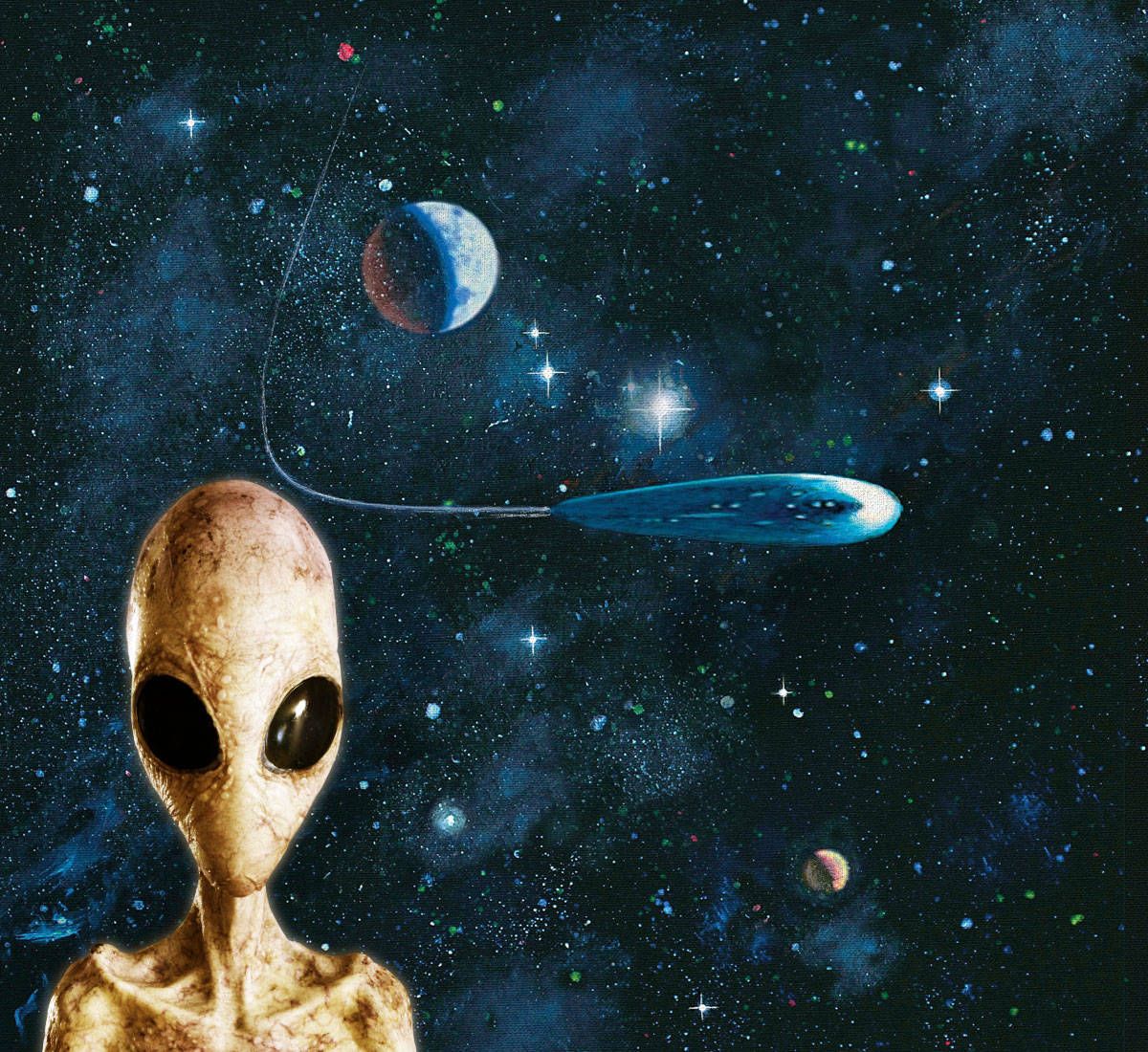MORE COVERAGE
Twitter Coverage
Satyaagrah
Written on
Satyaagrah
Written on
Satyaagrah
Written on
Satyaagrah
Written on
Satyaagrah
Written on
JOIN SATYAAGRAH SOCIAL MEDIA
Are We Alone in the Universe? NASA hints at the possibility of extra-terrestrial life, wants to establish New framework

How do we understand the significance of new scientific results related to the search for life? When would we be able to say, “yes, extraterrestrial life has been found?”
Our generation could realistically be the one to discover evidence of life beyond Earth. With this privileged potential comes responsibility. The magnitude of the question of whether we are alone in the Universe, and the public interest therein, opens the possibility that results may be taken to imply more than the observations support, or than the observers intend.
As life-detection objectives become increasingly prominent in space sciences, it is essential to open a community dialogue about how to convey information in a subject matter that is diverse, complicated and has a high potential to be sensationalized.
Establishing best practices for communicating about life detection can serve to set reasonable expectations on the early stages of a hugely challenging endeavour, attach value to incremental steps along the path, and build public trust by making clear that false starts and dead ends are an expected and potentially productive part of the scientific process.
On Monday (October 25), the National Aeronautics and Space Administration (NASA) issued a press release highlighting the possible discovery of a planet outside the Milky Way galaxy. The exoplanet candidate is located in the Messier 51 (M51) galaxy (Whirpool galaxy) and was detected using the Chandra X-ray Observatory.
 “Are there other planet Earths out there?" NASA administrator Bill Nelson said. "I certainly think so, because the universe is so big." |
It was the first time that NASA scientists had discovered an exoplanet candidate outside the Milky Way galaxy. Until now, astronomers have identified exoplanets as far as 3000 light-years away from the Earth. However, the exoplanet candidate in the M51 galaxy is estimated to be about 28 million light-years away. The feat was achieved using a new strategy and was led by Rosanne Di Stefano. “We are trying to open up a whole new arena for finding other worlds by searching for planet candidates at X-ray wavelengths, a strategy that makes it possible to discover them in other galaxies,” she remarked.
The new technique can help in the detection of exoplanets that are located a distance greater than current optical light transit studies. Based on the data collected by the scientists, they estimated that the size of the newly discovered exoplanet candidate (denoted as M51-ULS-1) would be the same as the Saturn. However, the study would require more data to confirm the interpretation of scientists. Due to the large orbit of the exoplanet candidate, it will take about 70 years or more to reach a conclusion.
 The location of the possible exoplanet candidate (Image Courtesy: X-ray: NASA/CXC/SAO/R. DiStefan) |
“Unfortunately to confirm that we’re seeing a planet we would likely have to wait decades to see another transit…And because of the uncertainties about how long it takes to orbit, we wouldn’t know exactly when to look,” informed Nia Imara, who co-authored the study. Another scientist who was part of the project, Julia Berndtsson, stated, “We know we are making an exciting and bold claim so we expect that other astronomers will look at it very carefully. We think we have a strong argument, and this process is how science works.”
During the study, Rosanne Di Stefano and the other co-authors looked for X-ray transits in 3 galaxies, located outside the Milky Way galaxy. The Chandra X-ray Observatory and European Space Agency’s XMM-Newton were used to cover a total of 64 systems in Messier 101 galaxy, 119 systems in the Messier 104 galaxy and 55 systems in the Messier M51 galaxy. The scientists will continue to look for potential exoplanet candidates using the archives of XMM-Newton and Chandra X-ray Observatory.
The recent feat achieved by NASA has again ignited the debate around the existence of extra-terrestrial life (aka aliens.) In a tweet on Thursday (October 28), the space agency remarked, “Are we alone in the universe? To understand how one discovery builds on the next, @NASAAstrobio is asking for help to put together a scale that would lead to scientists being confident in saying they found life beyond Earth.”
|
In an article in the journal Nature, NASA chief scientist Jim Green emphasised on the need for developing a scale to report instances of extraterrestrial life. “Our generation could realistically be the one to discover evidence of life beyond Earth. With this privileged potential comes responsibility. The magnitude of the question of whether we are alone in the Universe, and the public interest therein, opens the possibility that results may be taken to imply more than the observations support, or than the observers intend,” read the abstract of the research paper.
NASA is encouraging the scientists to develop a new framework that can help provide context to the findings of ‘extra-terrestrial life.’ Jim Green underlined how discussions around the discovery of extraterrestrial life could result in sensationalisation. He, therefore, provided a sample scale called the Confidence of Life Detection (CoLD) scale that can be used as a starting point for discussions about such life forms among scientists and communicators. He stated, “Having a scale like this will help us understand where we are in terms of the search for life in particular locations, and in terms of the capabilities of missions and technologies that help us in that quest.”
|
Green’s scale contains 7 levels, which can help scientists to declare that they have found life beyond Earth. At Level 1, scientists will report evidence about the ‘signature of life’. It can include traces of biologically relevant molecules. According to Jim Green, at level 2, the scientists must ensure that their findings/detection was not influenced by earth-borne contamination. The focus for the Level 3 and Level 4 must be to establish that the finding is a biological event and not a chemical one. While Level 3 pertains to demonstrating that the biological source is capable of producing signals, Level 4 involves removing non-biological sources from that environment.
According to Green, Level 5 is achieved when an additional independent biological signal is detected. At Level 6, scientists announce alternative hypotheses after excluding the first detection. Level 7 is reached when scientists make independent confirmation of additional biological behaviours. While Green conceded that the CoLD scale may not be accepted by the whole of the global scientific community, it however can pave the way for the development of a new framework. While putting his scale to practice, the chief scientist at NASA had informed that a 4.5-billion-year old Martian meteorite ALH84001 reached only Level 3 on the scale.
“Realizing this potential requires a community-level dialogue among scientists, technologists and the media to agree on objective standards of evidence for life and best practices for communicating that evidence. Doing so before life-detection results are reported, rather than in response to a specific finding, will enable a more dispassionate, objective, and broad-reaching treatment of the subject and ensure that its packaging supports clear understanding by the public at large. The purpose of this Perspective is to call for such dialogue and propose a draft framework and set of considerations to seed the discussion,” the article concluded.
Meanwhile, Bill Nelson, NASA administrator under the Joe Biden administration, said recently that “we hope it’s not an adversary here on Earth that has that kind of technology,” speaking about the unidentified aerial phenomena spotted by men in the US Navy.
Nelson said, “Before we leave, I haven’t even talked about the search for extraterrestrial life. What do you think we’re doing on Mars? We’re looking for life. This is a part of NASA’s mission. That’s what this telescope is gonna be looking for. Are there other planets elsewhere that there is life?”
He added, “And they don’t know what it is, and we don’t know what it is. We hope it’s not an adversary here on Earth that has that kind of technology. But it’s something. And so, this is a mission that we’re constantly looking — what, who is out there? Who are we? How did we get here? How did we become as we are? How did we develop? How did we civilize? And are those same conditions out there in a universe that has billions of other suns in billions of other galaxies — it’s so large I can’t conceive it.”
The recent statements clearly indicate that very senior officials in the US Government are very seriously considering the possibility of the existence of extraterrestrial life and that we could possibly encounter them in the near future.
References:
nasa.gov - Written by Elizabeth Landau | NASA Headquarters
nature.com
Crowe, M. The Extraterrestrial Life Debate: Antiquity to 1915: A Source Book (Univ. Notre Dame Press, 2008)
Dick, S. J. Life on Other Worlds: The 20th-Century Extraterrestrial Life Debate (Cambridge Univ. Press, 1998)
Blastland, M. et al. Five rules for evidence communication. Nature 587, 362–364 (2020). A commentary on effective science communication
opindia.com - OpIndia Staff
 Support Us
Support Us
Satyagraha was born from the heart of our land, with an undying aim to unveil the true essence of Bharat. It seeks to illuminate the hidden tales of our valiant freedom fighters and the rich chronicles that haven't yet sung their complete melody in the mainstream.
While platforms like NDTV and 'The Wire' effortlessly garner funds under the banner of safeguarding democracy, we at Satyagraha walk a different path. Our strength and resonance come from you. In this journey to weave a stronger Bharat, every little contribution amplifies our voice. Let's come together, contribute as you can, and champion the true spirit of our nation.
 |  |  |
| ICICI Bank of Satyaagrah | Razorpay Bank of Satyaagrah | PayPal Bank of Satyaagrah - For International Payments |
If all above doesn't work, then try the LINK below:
Please share the article on other platforms
DISCLAIMER: The author is solely responsible for the views expressed in this article. The author carries the responsibility for citing and/or licensing of images utilized within the text. The website also frequently uses non-commercial images for representational purposes only in line with the article. We are not responsible for the authenticity of such images. If some images have a copyright issue, we request the person/entity to contact us at satyaagrahindia@gmail.com and we will take the necessary actions to resolve the issue.
Related Articles
- Giant hypocrite: Activist confronts Twitter CEO over censorship, asks why he ‘hates Jews and Conservatives’
- Twitter says it removed verified badge from Vice President Venkaiah Naidu’s account due to ‘inactivity’: Here is why their argument is flawed
- Just after the verification badge of VP of India was restored, Twitter removes verification of RSS Chief Mohan Bhagwat, bureaucrat
- “Covid-19 virus is from China and it was intentionally leaked by China’s CCP” says Chinese virologist
- 'Badhai ho India': India crosses one billion vaccination milestone
- Government of India gives Twitter "one last notice" as "gesture of goodwill" to comply with IT Rules, 2021
- 130 attackers arrested in Noakhali, Bangladesh for violence against Hindus: So far out of thousands unnamed Islamists booked
- Anti-virus software pioneer John McAfee hangs himself in a Spanish jail, old tweets spark conspiracy theories
- Ten most compelling evidence of Extraterrestrial existence from 2020
- Big Liberals, small hearts: By donating 80 vials of vaccine, America has proved to be the poorest country in the world
- Modi govt invites applications from non-Muslim refugees from Afghanistan, Pakistan, Bangladesh to grant Indian citizenship
- Trump blasts Fauci after release of Covid-19 emails, says it vindicates his ‘lab origin’ theory and demands China pay $10 Trillion
- Negative sentiments about China and Xi Jinping at a record high among most advanced countries: Pew Research study
- Jagannath Temple administration issues clarification on proposed sale of temple lands
- Farmers Truck protest is a new swag worldwide now: Canadian PM Justin Trudeau goes in hiding with family in a secret ‘undisclosed’ location after thousands of truckers carried out protests over vaccine mandates

























